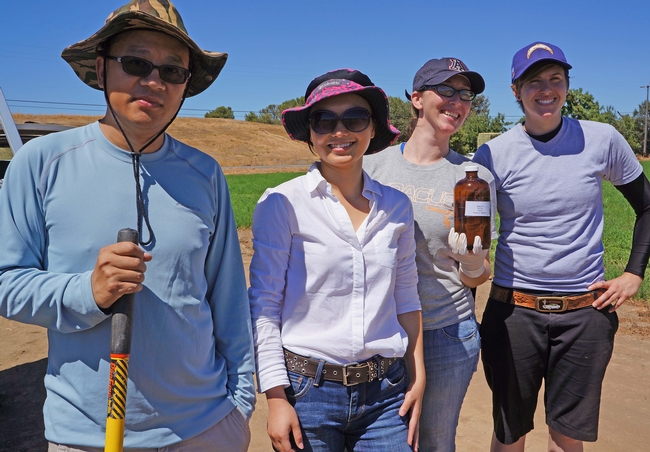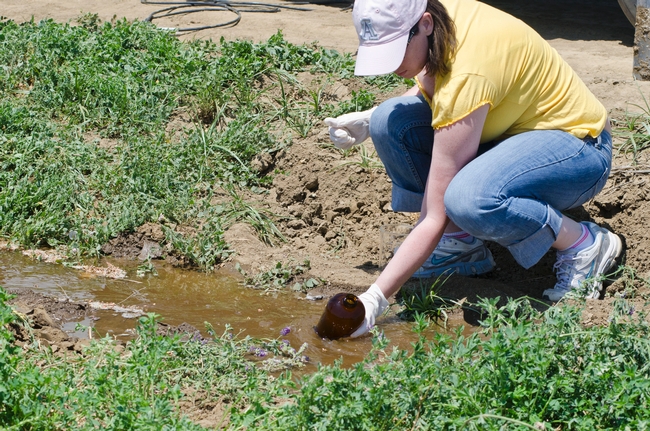There is no question that managing pests in alfalfa is a challenge. But it’s even more of a challenge considering that we need to consider how our chemical tools impact our environment. Why is this is important? Two reasons: 1) no grower wants to pollute our natural waterways or wells, 2) ultimately unwanted environmental impacts will cause the loss of these pesticide tools over time. This became evident last year when the detection of the herbicide Velpar (hexazinone) in wells caused DPR to threaten to pull the registration. After hearings with members of the California Alfalfa & Forage Association and scientists in Sacramento, ultimately growers were able to keep Velpar, but it should have been a wake-up call about the potential for water impacts of chemicals used in alfalfa.
Pesticide water quality issues continue to be a concern for alfalfa fields that drain into natural waterways. The products used in alfalfa that are most troublesome include the herbicide diuron (Karmex or Direx), Velpar, and the insecticide chlorpyrifos (Lorsban, Lock-On, Cobalt, Stallion). Diuron is used for winter weed control in alfalfa (primarily as a pre-emergence material) while chlorpyrifos is used for weevil control. Velpar is very important for controlling groundsel in alfalfa. All of these pesticides move with water (irrigation and storm water runoff) after they are applied to fields.
The Water Quality Coalition groups have reported detections of chlorpyrifos and diuron in several of the alfalfa growing areas of the Sacramento and San Joaquin Valleys.
Diuron is relatively persistent in the environment. It has a low tendency to attach to soil particles, has a high aquatic toxicity, and the field dissipation half-life is 90 days. This herbicide is also a groundwater issue in some areas of our state. Chlorpyrifos has a moderate tendency to attach to soil particles, but is very highly toxic to aquatic invertebrates (in parts per trillion) with a half-life of 43 days.
Numerous exceedances have occurred in waterways for both diuron and chlorpyrifos, requiring the implementation of management plans to reduce the concentration of these pesticides to levels that are not toxic to aquatic test species. The development of these management plans, as required by the Regional Water Quality Control Board, are very expensive and time consuming to implement. They require huge amounts of staff time to write reports and additional monitoring requirements.
UCCE is conducting field studies in collaboration with growers and CA DPR and UC Davis to better understand how to minimize offsite movement of these products into surface waters. Current guidelines include the following:
- If you are managing large alfalfa acreage, consider using multiple pesticide chemistries on different fields to reduce the cumulative effect of any one active ingredient.
- Study your water systems and look for ways to recirculate water back onto agricultural fields and to prevent drainage water from entering natural waterways.
- Use alternative products that have less water impacts on those fields where drainage is difficult to prevent - lists by crop and pest are available on the UC IPM guidelines at: http://ipm.ucdavis.edu/PMG/selectnewpest.alfalfa-hay.html
- Use extreme caution during applications. Eliminate drift and overspray, especially near ditches (supply and drainage).
- Do not apply to saturated soils where the danger of off-site movement is greater.
- Do not apply just prior to a runoff event or irrigation.
- Several approaches such as alternative products on field perimeters have been shown to reduce the off-site movement of the more problematic chemicals.
 Department of Pesticide Regulation team working on alfalfa to better understand how to minimize impacts of pesticides on water quality.
Department of Pesticide Regulation team working on alfalfa to better understand how to minimize impacts of pesticides on water quality.
Attached Images:

